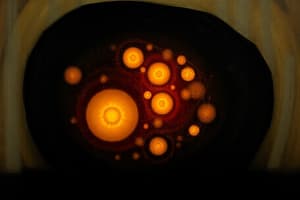Podcast
Questions and Answers
What is the primary function of microtubules in a cell?
What is the primary function of microtubules in a cell?
- Determining the shape of the cell (correct)
- Assisting in detoxification processes
- Aiding in cell division
- Regulating gene expression
Which cellular component is primarily responsible for resisting external pressure?
Which cellular component is primarily responsible for resisting external pressure?
- Intermediate Filaments (correct)
- Microfilaments
- Microtubules
- H2O2 metabolism
What is the composition of microfilaments?
What is the composition of microfilaments?
- Solid actin fibers (correct)
- Cell-specific proteins
- Hollow structures
- Various subunits
What is the role of peroxisomes in a cell?
What is the role of peroxisomes in a cell?
Which cellular structure plays a crucial role in maintaining the structure of the cell?
Which cellular structure plays a crucial role in maintaining the structure of the cell?
What happens when intermediate filaments are abnormal in humans?
What happens when intermediate filaments are abnormal in humans?
Which component within the nucleus organizes genetic material and localizes nuclear functions?
Which component within the nucleus organizes genetic material and localizes nuclear functions?
What is the significance of microtubules in ciliary and flagellar motion?
What is the significance of microtubules in ciliary and flagellar motion?
How do microfilaments contribute to cell motion?
How do microfilaments contribute to cell motion?
What type of structures are microtubules?
What type of structures are microtubules?
Flashcards are hidden until you start studying
Study Notes
Cell: Structure and Function
- Cell is the fundamental unit of life, self-replicating, and can be unicellular or multicellular.
- First cells were observed by Robert Hooke in 1665 from a slice of cork, with a diameter of 2-120µm.
Cell Theory
- Proposed by Matthias Schleiden and Theodor Schwann in 1839:
- All living things are made up of cells.
- Cells are the smallest working unit of all living things.
- All cells come from pre-existing cells through cell division.
Protoplasm
- Composed of:
- Water (70-80%)
- Carbohydrates
- Lipids
- Proteins
- Electrolytes (Sodium, Potassium, Magnesium, Calcium, Phosphate, Chloride, and Bicarbonate)
Cell Membrane
- Thin elastic outermost structure that envelops the cell.
- Consists of bilipid layer with embedded proteins: integral proteins and peripheral proteins.
Functions of Cell Membrane
- Protective: forms outermost boundary of the cell organelles.
- Digestive: takes in food and excretes waste products.
- Selective Permeability: allows non-polar molecules to dissolve and move rapidly across the membrane, while polar molecules have lower solubility.
Cytoplasm
- Thick, gel-like semitransparent fluid found in both plant and animal cells.
- Constituent parts: cytosol, cell organelles, and cytoplasmic inclusions.
- Bounded by the plasma membrane and contains many organelles in a eukaryotic cell.
Mitochondria
- First observed by Kolliker in 1850 as granular structures in the striated muscles.
- Called the 'powerhouse of the cell'.
Endoplasmic Reticulum
- Network of tubular and flat vesicular structures in the cytoplasm.
- Extensive network of closed, flattened membrane-bounded sacs called cisternae.
- Space inside the tubules is filled with Endoplasmic Matrix.
Types of Endoplasmic Reticulum
- Smooth Endoplasmic Reticulum: site of synthesis of lipid and steroid hormones.
- Rough Endoplasmic Reticulum: site of protein synthesis, processing, and packaging.
Golgi Bodies
- Collection of membrane-enclosed sacs composed of four or more stacked layers of thin, flat enclosed vessels.
- Consist of multiple discrete compartments.
- Functions:
- Wrapping and packaging department of the cell.
- Site of formation of lysosomes.
- Adds certain carbohydrates to form glycoproteins.
Lysosome
- Irregular structures surrounded by the unit membrane.
- Acts as a form of digestive (lytic) system or the cell.
- Engulf worn out components of the cells in which they are located.
- When a cell dies, lysosomal enzymes cause autolysis of the remnant.
Peroxisome
- Lipid bilayer membrane surrounds which regulates what enters or exits the peroxisomes.
- Structure is similar to that of the lysosomes but with a different composition.
- Functions: H2O2 metabolism and detoxification.
Cytoskeleton
- System of fibers that maintains the structure of the cell and permits it to change shape and move.
- Made up primarily of:
- Microtubules
- Intermediate Filaments
- Microfilaments
Cytoskeleton Components
- Microtubules: long hollow structures that determine the shape of the cell, role in the contraction of the spindle and movement of chromosomes and centrioles.
- Intermediate Filaments: flexible scaffolding or cell, help it resist external pressure.
- Microfilaments: long solid fibers responsible for the cell motion.
Nucleus
- Contains chromatin, RNAs, and nuclear proteins that move freely in aqueous solution.
- Has an internal structure that organizes the genetic material and localizes nuclear functions.
- Serves both as the repository of genetic information and as the cell's control center.
Studying That Suits You
Use AI to generate personalized quizzes and flashcards to suit your learning preferences.




